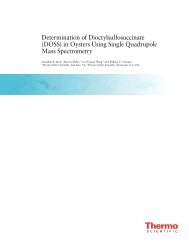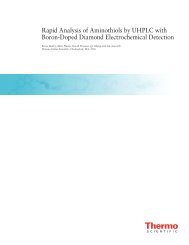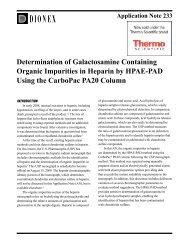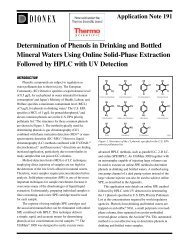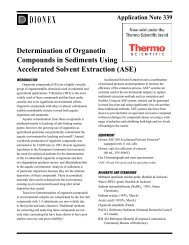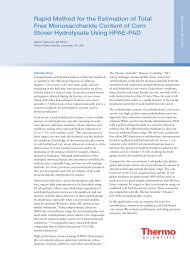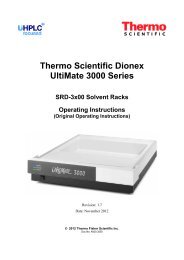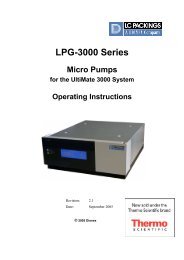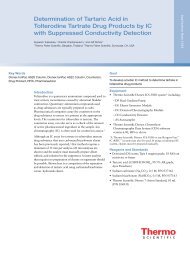CarboPac PA1 and PA10 Columns for Mono and ... - Dionex
CarboPac PA1 and PA10 Columns for Mono and ... - Dionex
CarboPac PA1 and PA10 Columns for Mono and ... - Dionex
Create successful ePaper yourself
Turn your PDF publications into a flip-book with our unique Google optimized e-Paper software.
columns<br />
HPLC <strong>Columns</strong> <strong>for</strong> Quantitative<br />
Analysis of <strong>Mono</strong>- <strong>and</strong> Disaccharides<br />
Over an Extensive Range of Sample<br />
Matrices<br />
• Reduced mono- <strong>and</strong> disaccharides<br />
• Glycoprotein monosaccharide<br />
compositional analysis<br />
• Linear polysaccharides<br />
• Acidic oligosaccharides<br />
• Exceptionally high sensitivity<br />
• Specialized traps <strong>for</strong> interferencefree<br />
quantification<br />
<strong>CarboPac</strong> <strong>PA1</strong> <strong>and</strong> <strong>PA1</strong>0 <strong>Columns</strong><br />
<strong>for</strong> <strong>Mono</strong>- <strong>and</strong> Disaccharide Analysis<br />
Unique Column Chemistry <strong>for</strong> Optimal<br />
Per<strong>for</strong>mance<br />
The <strong>CarboPac</strong> <strong>PA1</strong> <strong>and</strong> <strong>PA1</strong>0<br />
are specialized anion-exchange columns<br />
designed to be used with pulsed<br />
amperometric detection to deliver high<br />
resolution separations of mono- <strong>and</strong><br />
disaccharides. Both resins consist of<br />
10-µm diameter nonporous beads<br />
covered with a fine latex of functionalized<br />
MicroBeads. This pellicular resin<br />
structure permits excellent mass transfer,<br />
resulting in high resolution chromatography<br />
<strong>and</strong> rapid reequilibration.<br />
Passion. Power. Productivity.<br />
The <strong>CarboPac</strong> <strong>PA1</strong> is a rugged<br />
all-purpose column suitable <strong>for</strong> determining<br />
monosaccharides <strong>and</strong> disaccharides<br />
in a variety of matrices. It is also<br />
the column of choice <strong>for</strong> high resolution<br />
separations of linear polysaccharides.<br />
The <strong>CarboPac</strong> <strong>PA1</strong>0 is optimized<br />
to determine the amino, neutral, <strong>and</strong><br />
acidic monosaccharides that are found<br />
in the carbohydrate moieties of mammalian<br />
glycoproteins. It is the column<br />
of choice <strong>for</strong> high sensitivity monosaccharide<br />
analyses, in conjunction with<br />
the EG40 Eluent Generator <strong>and</strong> the<br />
AminoTrap column.
Reduced <strong>Mono</strong>- <strong>and</strong> Disaccharides<br />
The separation of alditols <strong>and</strong><br />
sugars is of interest to both the food <strong>and</strong><br />
pharmaceutical industries, in matrices<br />
such as fruits <strong>and</strong> vegetables as well<br />
as drug <strong>for</strong>mulations. Figure 1 shows<br />
the use of the <strong>CarboPac</strong> <strong>PA1</strong>0 <strong>for</strong> the<br />
separation of mixtures of sugar alcohol<br />
monosaccharides <strong>and</strong> disaccharides.<br />
The <strong>CarboPac</strong> <strong>PA1</strong>0 is the column<br />
of choice <strong>for</strong> the separation of food<br />
sugars <strong>and</strong> food alcohols in a single run.<br />
However, if complex mixtures of sugar<br />
alcohols are present, the high capacity<br />
<strong>CarboPac</strong> MA1 should be used.<br />
Because alditol retention is only<br />
slightly affected by the sodium hydroxide<br />
concentration between 18 mM <strong>and</strong><br />
50 mM, monosaccharide <strong>and</strong> disaccharide<br />
separations can be optimized by<br />
increasing the hydroxide concentration<br />
while still maintaining adequate alditol<br />
retention.<br />
As discussed in the “Specialized<br />
Traps <strong>for</strong> Interference-Free Quantification”<br />
section, use of the BorateTrap <br />
column greatly improves the peak shape<br />
of the alditols <strong>and</strong> is highly recommended<br />
<strong>for</strong> quantitative analyses.<br />
Glycoprotein <strong>Mono</strong>saccharide<br />
Compositional Analysis<br />
The <strong>CarboPac</strong> <strong>PA1</strong> <strong>and</strong> <strong>PA1</strong>0 are<br />
ideal <strong>for</strong> the quantification of amino,<br />
acidic, <strong>and</strong> neutral monosaccharides,<br />
especially those derived from glycoconjugates.<br />
The <strong>CarboPac</strong> <strong>PA1</strong>0 column<br />
gives a baseline separation of mammalian<br />
monosaccharides over a broader<br />
range of isocratic sodium hydroxide<br />
concentrations than the <strong>CarboPac</strong> <strong>PA1</strong><br />
(Figure 2). With the AminoTrap column<br />
in-line, the <strong>CarboPac</strong> <strong>PA1</strong>0 offers<br />
lowered detection limits, elimination of<br />
interference from oxygen, <strong>and</strong> faster run<br />
times.<br />
nC<br />
A<br />
50<br />
0<br />
B<br />
120<br />
nC<br />
0<br />
0<br />
0<br />
1<br />
1<br />
2<br />
3<br />
2<br />
3<br />
4<br />
4<br />
2<br />
4<br />
5<br />
5<br />
5<br />
6<br />
Minutes<br />
6<br />
6 8 10 12 14<br />
Minutes<br />
Figure 1. The <strong>CarboPac</strong> <strong>PA1</strong>0 resolves mixtures of sugar alcohols. A) Sugar alcohols <strong>and</strong><br />
other carbohydrates found in foods. B) Glycols, sugar alcohols, <strong>and</strong> carbohydrates in a<br />
pharmaceutical <strong>for</strong>mulation.<br />
nC<br />
Figure 2. Comparison of the <strong>CarboPac</strong> <strong>PA1</strong> <strong>and</strong> <strong>PA1</strong>0 <strong>for</strong> glycoprotein monosaccharides.<br />
7<br />
Column: <strong>CarboPac</strong> <strong>PA1</strong>0 <strong>and</strong> guard,<br />
Eluent:<br />
BorateTrap<br />
52 mM Sodium hydroxide<br />
Flow Rate: 1.5 mL/min<br />
Inj Volume: 5 µL<br />
Detection: Pulsed amperometry,<br />
ED40, gold electrode<br />
7<br />
Peaks: 1. Glycerol 4.0 µg/mL (ppm)<br />
8<br />
2. Xylitol<br />
3. Sorbitol<br />
2.0<br />
1.5<br />
4. Mannitol 3.0<br />
5. Glucose 5.0<br />
6. Fructose 8.0<br />
7. Sucrose 2.0<br />
8. Lactose 8.0<br />
10 15<br />
Column: <strong>CarboPac</strong> <strong>PA1</strong>0 <strong>and</strong> guard<br />
Eluent: 18 mM Sodium hydroxide<br />
Flow Rate: 1.5 mL/min<br />
Inj Volume: 10 µL<br />
Detection: Pulsed amperometry,<br />
ED40, gold electrode<br />
Peaks: 1. Propylene glycol<br />
2. Glycerol<br />
3. Sorbitol<br />
4. Mannitol<br />
5. Maltitol<br />
6. Glucose<br />
7. Sucrose<br />
Flow Rate: 1.5 mL/min<br />
Eluent: Sodium hydroxide<br />
Detection: Pulsed amperometry, ED40,<br />
gold electrode<br />
Peaks: 1. Fucose<br />
2. Galactosamine<br />
3. Glucosamine<br />
4. Galactose<br />
5. Glucose<br />
6. Mannose<br />
<strong>PA1</strong>0 <strong>PA1</strong><br />
1 2<br />
3 4 5 6<br />
1 2<br />
3 4 56 24 mM<br />
0 5<br />
22 mM<br />
20 mM<br />
18 mM<br />
16 mM<br />
14 mM<br />
12 mM<br />
10 15 20 0 5 10 15 20<br />
12236-01<br />
13155<br />
12289
Linear Polysaccharides<br />
Chain length distribution is an<br />
important parameter in starch characterization.<br />
HPAE-PAD technology featuring<br />
the <strong>CarboPac</strong> <strong>PA1</strong> delivers single-residue<br />
resolution of linear polysaccharides up<br />
to a degree of polymerization (DP) of at<br />
least 60. Figure 3 shows the chain length<br />
distribution of a sample of purified inulin<br />
using the <strong>CarboPac</strong> <strong>PA1</strong>. Commercial<br />
inulin products have DPs that have been<br />
tailored <strong>for</strong> a particular end use; there<strong>for</strong>e,<br />
it is important to determine the<br />
chain length distribution during product<br />
development <strong>and</strong> production <strong>and</strong> <strong>for</strong><br />
quality control of the end product. Figure<br />
3 illustrates the excellent resolution that<br />
can be acheived <strong>for</strong> DP values up to 50<br />
or more <strong>for</strong> purified inulin.<br />
Acidic Oligosaccharides<br />
Sialic acids comprise a large family<br />
of N- <strong>and</strong> O-substituted neuraminic<br />
acids. They occupy terminal positions<br />
on many mammalian glycoproteins <strong>and</strong><br />
glycolipid oligosaccharides. When a<br />
glycoprotein loses sialic acid residues,<br />
it has a reduced serum half-life <strong>and</strong> in<br />
some cases reduced activity. There<strong>for</strong>e<br />
it is important to know the sialic acid<br />
content of a glycoprotein when assaying<br />
its function or its efficacy as a pharmaceutical<br />
therapeutic. HPAE-PAD is an<br />
effective way to determine Neu5Ac <strong>and</strong><br />
Neu5Gc without derivatization, <strong>and</strong> can<br />
be per-<strong>for</strong>med with either the <strong>CarboPac</strong><br />
<strong>PA1</strong> or <strong>CarboPac</strong> <strong>PA1</strong>0.<br />
The elution of acidic sugars from<br />
the <strong>CarboPac</strong> <strong>PA1</strong> or <strong>CarboPac</strong> <strong>PA1</strong>0<br />
column requires stronger eluents than<br />
those used <strong>for</strong> neutral sugars (Figures<br />
4 <strong>and</strong> 5). This is usually accomplished<br />
by the addition of sodium acetate to the<br />
sodium hydroxide eluent. Sodium acetate<br />
accelerates the elution of strongly bound<br />
species without interfering with pulsed<br />
amperometric detection.<br />
Figure 3. Chromatographic analysis of purified inulin.<br />
20<br />
nC<br />
0<br />
20<br />
nC<br />
0<br />
Column: <strong>CarboPac</strong> <strong>PA1</strong><br />
Eluent: A) 0.1 M NaOH<br />
B) 0.1 M NaOH, 1.0 M NaOH<br />
Gradient: 20–60% B in 40 min<br />
Flow Rate: 1 mL/min<br />
Detection: Pulsed amperometry,<br />
PAD, gold electrode<br />
Range: 3000 nA<br />
Sample: 0.3% Water Washed Inulin<br />
(Polyfructose) in 0.1 M NaOH<br />
Sample Courtesy of Dr. C. Mitchell<br />
Cali<strong>for</strong>nia Natural Products, Manteca, CA<br />
Figure 4. Sialic acid analysis of bovine transferrin on the <strong>CarboPac</strong> <strong>PA1</strong>0.<br />
0<br />
Column: <strong>CarboPac</strong> <strong>PA1</strong><br />
Flow Rate: 1.0 mL/min<br />
Detector: Pulsed amperometry,<br />
PAD, gold electrode<br />
Range: 10,000 nA<br />
Eluent A: 100 mM NaOH<br />
Eluent B: 100 mM NaOH,<br />
1.0 M NaOAc<br />
Gradient:<br />
10<br />
A 0.1 N HCI Digestion<br />
1<br />
3 4<br />
2<br />
10<br />
6<br />
5<br />
20<br />
0 10 20<br />
Minutes<br />
B Neuraminidase Digestion<br />
0 5 10<br />
Minutes<br />
1<br />
1<br />
t %A %B<br />
0 90 10<br />
20 80 20<br />
30 50 50<br />
2<br />
7<br />
20<br />
Minutes<br />
50<br />
3<br />
2 3<br />
8 9 11<br />
10<br />
30 40<br />
Column: <strong>CarboPac</strong> <strong>PA1</strong>0<br />
Sample Vol.: 25 µL<br />
Eluent: A) 100mM NaOH<br />
B) 100mM NaOH with 1M NaOAc<br />
Gradient: 7% B to 30% B in 30 minutes<br />
Flow Rate: 1mL/min<br />
Detection: Pulsed amperometry,<br />
ED40, gold electrode<br />
Peaks: 1. Neu5Ac<br />
2. KDN<br />
3. Neu5Gc<br />
Figure 5. Analysis of mono- <strong>and</strong> diphosphorylated monosaccharides on the <strong>CarboPac</strong> <strong>PA1</strong>.<br />
30<br />
12<br />
13<br />
14 15<br />
40<br />
3073-01<br />
13097<br />
Peaks: 1. α-D-Galactosamine -1-P 1.13 µg<br />
2. α-D-Glucosamine-1-P 0.45<br />
3. α-D-Galactose-1-P 1.75<br />
4. α-D-Glucose-1-P 1.75<br />
5. α-D-Ribose-1-P 1.46<br />
6. ß- D-Glucose-1-P 1.75<br />
7. D-Glucosamine-6-p 3.75<br />
8. D-Galactose-6-P 2.04<br />
9. D-Glucose-6-P<br />
1.25<br />
10. D-Fructose-1-P 0.96<br />
11. D-Fructose-6-P 0.42<br />
12. α-D-Glucuronic acid-1-P 3.08<br />
13. α-D-Glucose-1,6-Di P 1.06<br />
14. ß-D-Fructose-2,6-Di P 0.92<br />
3169
High Throughput, High Sensitivity<br />
Analyses<br />
Figure 6 shows typical resolution<br />
<strong>for</strong> the separation of 5 pmol each of six<br />
monosaccharides using the <strong>CarboPac</strong><br />
<strong>PA1</strong>0 column. The EG40 on-line eluent<br />
generator can be used to ensure reproducible<br />
separations by producing carbonate-free<br />
hydroxide eluent. Carbonate<br />
in the eluent results in decreased retention<br />
times <strong>and</strong> diminished resolution.<br />
The EG40 is used in conjunction<br />
with the <strong>CarboPac</strong> <strong>PA1</strong>0 <strong>and</strong> the AminoTrap<br />
columns <strong>for</strong> reproducible, high<br />
throughput, high sensitivity carbohydrate<br />
applications (Figure 7). The advantages<br />
of the use of the EG40 <strong>for</strong> carbohydrate<br />
analysis include simplified eluent generation,<br />
because only degassed deionized<br />
water is required. Problems caused by<br />
minor differences in prepared eluents are<br />
avoided, as are salt deposits in the pump.<br />
The AminoTrap column is used<br />
to move the amino acids beyond the<br />
retention time of the analytes. This allows<br />
<strong>for</strong> quantitative analysis since the<br />
amino acids no longer interfere with the<br />
separation of the monosaccharides.<br />
Specialized Traps <strong>for</strong> Interference-Free<br />
Quantification<br />
Borate can affect monosaccharide<br />
peak symmetry, even when present in<br />
the low part-per-billion concentration<br />
range. Borate is one of the first ions to<br />
break through a water deionization system.<br />
Its presence in water used to make<br />
eluents causes a significant loss of peak<br />
efficiency, especially <strong>for</strong> mannose <strong>and</strong><br />
reduced monosaccharides. The BorateTrap<br />
column is used immediately be<strong>for</strong>e<br />
the injection valve to remove borate<br />
from the eluent prior to sample injection<br />
(Figure 8).<br />
Figure 6. High sensitivity analysis using the <strong>CarboPac</strong> <strong>PA1</strong>0.<br />
tr (min)<br />
16.6<br />
nC<br />
16.1<br />
16<br />
12<br />
8<br />
4<br />
Regen.<br />
0<br />
Quadruple Potential Wave<strong>for</strong>m<br />
2<br />
Std<br />
Btfn<br />
Hyd Std<br />
Std<br />
Btfn<br />
Hyd Std<br />
Std<br />
Btfn<br />
Hyd Std<br />
12<br />
1<br />
0 2<br />
4 6<br />
Minutes<br />
8 10 12<br />
24<br />
36<br />
3<br />
Man<br />
4<br />
Hyd Std<br />
Btfn<br />
Std<br />
Column: AminoTrap, <strong>CarboPac</strong> <strong>PA1</strong>0<br />
Eluent: 18 mM Sodium Hydroxide<br />
Flow Rate: 1.5 mL/min<br />
Detection: Pulsed Amperometry, ED40, gold electrode<br />
Peaks 1. Fucose 5 pmol<br />
2. Galactosamine 5<br />
5<br />
3. Glucosamine 5<br />
6 4. Galactose 5<br />
5. Glucose 5<br />
6. Mannose 5<br />
Std<br />
Btfn<br />
Hyd Std<br />
48 60<br />
Injection Number<br />
Std<br />
Btfn<br />
Hyd Std<br />
Figure 7. <strong>Mono</strong>saccharide retention time stability: Isocratic on-line eluent generation (30<br />
min/sample plus 5 min regeneration at 100 mM sodium hydroxide to ensure amino acids are<br />
eluted).<br />
Figure 8. Effect of borate <strong>and</strong> the BorateTrap column on monosaccharide peak symmetry.<br />
GlcN<br />
72<br />
Fuc<br />
Btfn<br />
Std<br />
Hyd Std<br />
Std<br />
Btfn<br />
Hyd Std<br />
84<br />
96<br />
Std<br />
Btfn<br />
Hyd Std<br />
108<br />
Column: <strong>CarboPac</strong> <strong>PA1</strong>0<br />
Eluent: 18 mM Sodium NaOH,<br />
10 ng/mL borate<br />
Flow Rate: 1.5 mL/min<br />
Detection: Pulsed Amperometry, ED40, gold electrode<br />
Peaks 1. Fucose<br />
2. Galactosamine<br />
3. Glucosamine<br />
4. Galactose<br />
5. Glucose<br />
6. Mannose<br />
13549-01<br />
Std<br />
14533<br />
12234
The detection of monosaccharides<br />
<strong>and</strong> amine-containing glycoconjugates<br />
with low levels of glycosylation can be<br />
compromised from fouling of the working<br />
electrode by amino acids. Specifically<br />
designed to retain amino acids,<br />
the AminoTrap column allows monosaccharides<br />
to be eluted well be<strong>for</strong>e<br />
interfering amino acids such as lysine.<br />
The AminoTrap is a 4 x 50 mm in-line<br />
pretreatment column that is used be<strong>for</strong>e<br />
the <strong>CarboPac</strong> <strong>PA1</strong>0 analytical column<br />
instead of the <strong>CarboPac</strong> <strong>PA1</strong>0 guard<br />
column (Figure 9).<br />
Rugged, Reliable Analyses with<br />
Guaranteed Per<strong>for</strong>mance<br />
The polymeric <strong>CarboPac</strong> <strong>PA1</strong> <strong>and</strong><br />
<strong>PA1</strong>0 have a crosslinked structure to ensure<br />
long column life <strong>and</strong> stability from<br />
pH 0–14 at all concentrations of buffer<br />
salts (Figure 10). The <strong>CarboPac</strong> <strong>PA1</strong>0 is<br />
more highly crosslinked, making it more<br />
solvent compatible. The entire manufacturing<br />
process is carefully controlled in<br />
the <strong>Dionex</strong> ISO 9001-registered facility<br />
to ensure that every <strong>CarboPac</strong> column<br />
delivers reproducible per<strong>for</strong>mance. All<br />
<strong>CarboPac</strong> products are tested with a set<br />
of carbohydrate st<strong>and</strong>ards to ensure lotto-lot<br />
reproducibility.<br />
A Without AminoTrap<br />
3<br />
80<br />
nC<br />
80<br />
nC<br />
1<br />
2<br />
0<br />
0 5<br />
B With AminoTrap<br />
1<br />
0<br />
0 5<br />
2<br />
4<br />
10<br />
Minutes<br />
15 20<br />
Figure 9. Effect of the AminoTrap column on monosaccharide composition analysis of IgG<br />
hydrolysate.<br />
Figure 10. Pellicular anion-exchange resin bead.<br />
3<br />
5<br />
4<br />
5<br />
10<br />
Minutes<br />
15 20<br />
Column: <strong>CarboPac</strong> <strong>PA1</strong>0<br />
Eluent: 18 mM Sodium hydroxide<br />
Flow Rate: 1.5 mL/min<br />
Detection: Pulsed amperometry, ED40, gold electrode<br />
Peaks 1. Fucose<br />
2. Deoxyglucose (internal st<strong>and</strong>ard)<br />
3. Glucosamine<br />
4. Galactose<br />
5. Mannose<br />
Highly Crosslinked Core<br />
Latex MicroBeads<br />
with Anion Exchange<br />
Functionalities<br />
12190<br />
8674-B
Official Methods Using the<br />
<strong>CarboPac</strong> <strong>PA1</strong><br />
The <strong>CarboPac</strong> <strong>PA1</strong> has been approved<br />
<strong>for</strong> use in a number of official<br />
methods, including ISO/DIS 11292 <strong>for</strong><br />
coffee authenticity, International Committee<br />
of Uni<strong>for</strong>m Methods of Sugar<br />
Analysis (ICUMSA) <strong>for</strong> sugars in molasses,<br />
<strong>and</strong> AOAC Methods 996.04 <strong>and</strong><br />
2000.11. Figure 11 shows an example<br />
of an isocratic method to determine<br />
sugars in molasses. Table 1 lists official<br />
food methods using <strong>Dionex</strong> technology.<br />
nC<br />
8<br />
3<br />
0 2<br />
1<br />
2<br />
3<br />
4 6<br />
Minutes<br />
8 10<br />
4<br />
Column: <strong>CarboPac</strong> <strong>PA1</strong> <strong>and</strong> guard<br />
Eluent: 150 mM Sodium hydroxide<br />
Flow Rate: 1 mL/min<br />
Inj. Volume: 50 µL<br />
Detection: Pulsed amperometry<br />
Peaks 1. Glucose 4.39%<br />
2. Fructose 6.67<br />
3. Lactose (internal st<strong>and</strong>ard)<br />
4. Sucrose 30.8<br />
Figure 11. Isocratic separation of sugars found in sugarcane molasses. Official method of the<br />
International Commission <strong>for</strong> Uni<strong>for</strong>m Methods of Sugar Analysis.<br />
Table 1 Official fOOd MeThOds Using diOnex TechnOlOgy<br />
Analysis <strong>Dionex</strong> Technology Official Method<br />
Sugars in molasses HPAE-PAD/<strong>CarboPac</strong> <strong>PA1</strong> AOAC 996.04<br />
ICUMSA (1994)<br />
Carbohydrates in soluble coffee HPAE-PAD/<strong>CarboPac</strong> <strong>PA1</strong> AOAC 995.13<br />
ISO 11292<br />
Fructans in food HPAE-PAD/<strong>CarboPac</strong> <strong>PA1</strong> AOAC 997.08<br />
Anions in beer by IC IC with suppressed conductivity Analytica-EBC International Method<br />
Polydextrose HPAE-PAD/<strong>CarboPac</strong> <strong>PA1</strong> AOAC 2000.11<br />
Transgalacto-oligosaccharides HPAE-PAD/<strong>CarboPac</strong> <strong>PA1</strong> AOAC method validation study in progress<br />
10930
<strong>CarboPac</strong> <strong>PA1</strong><br />
Resin Composition:<br />
10-µm diameter substrate (polystyrene<br />
2% crosslinked with divinylbenzene)<br />
agglomerated with 500-nm MicroBead<br />
quaternary ammonium functionalized<br />
latex (5% crosslinked)<br />
Anion Exchange Capacity:<br />
Approximately 100 µeq/column<br />
(4 x 250 mm analytical column)<br />
Maximum Operating Pressure:<br />
4000 psi (27.9 MPa)<br />
Chemical Compatibility:<br />
pH 0–14<br />
Up to 2% of common HPLC solvents<br />
sPecificaTiOns<br />
<strong>CarboPac</strong> <strong>PA1</strong>0<br />
Resin Composition:<br />
10-µm diameter substrate (ethylvinylbenzene<br />
55% crosslinked with divinylbenzene)<br />
agglomerated with 460-nm<br />
MicroBead difunctional quaternary<br />
ammonium ion (5% crosslinked)<br />
Anion Exchange Capacity:<br />
Approximately 100 µeq/column<br />
(4 x 250 mm analytical column)<br />
Maximum Operating Pressure:<br />
4000 psi (27.9 MPa)<br />
Chemical Compatibility:<br />
pH 0–14<br />
Up to 90% of common HPLC solvents<br />
AminoTrap<br />
Resin Composition:<br />
10-µm diameter substrate (ethylvinylbenzene<br />
55% crosslinked with divinylbenzene)<br />
grafted with difunctional<br />
quaternary ammonium anion exchange<br />
sites<br />
Maximum Operating Pressure:<br />
4000 psi (27.9 MPa)<br />
Chemical Compatibility:<br />
pH 0–14<br />
Up to 90% of common HPLC solvents<br />
BorateTrap<br />
Resin Composition:<br />
20-µm diameter high capacity resin<br />
with very high selectivity <strong>for</strong> borate<br />
Maximum Operating Pressure:<br />
4000 psi (27.9 MPa)<br />
Chemical Compatibility:<br />
pH 0–14<br />
Up to 90% of common HPLC solvents
Ordering infOrMaTiOn<br />
In the U.S., call 1-800-346-6390 or contact the <strong>Dionex</strong> regional office nearest<br />
you. Outside the U.S., order through your local <strong>Dionex</strong> office or distributor. Refer<br />
to the following part numbers. <strong>Dionex</strong> can also make special-order <strong>CarboPac</strong><br />
columns to your specifications; call <strong>for</strong> more in<strong>for</strong>mation.<br />
Description Part Number<br />
<strong>CarboPac</strong> <strong>PA1</strong> Analytical Column<br />
<strong>CarboPac</strong> <strong>PA1</strong> Analytical Column (4 x 250 mm) ........................................035391<br />
<strong>CarboPac</strong> <strong>PA1</strong> Guard Column (4 x 50 mm) .................................................043096<br />
<strong>CarboPac</strong> <strong>PA1</strong> Analytical Column (2 x 250 mm) ........................................057178<br />
<strong>CarboPac</strong> <strong>PA1</strong> Guard Column (2 x 50 mm) ..................................................057179<br />
<strong>CarboPac</strong> <strong>PA1</strong>0 Analytical Column<br />
<strong>CarboPac</strong> <strong>PA1</strong>0 Analytical Column (4 x 250 mm) .......................................046110<br />
<strong>CarboPac</strong> <strong>PA1</strong>0 Guard Column (4 x 50 mm) ...............................................046115<br />
<strong>CarboPac</strong> <strong>PA1</strong>0 Analytical Column (2 x 250 mm) ......................................057180<br />
<strong>CarboPac</strong> <strong>PA1</strong>0 Guard Column (2 x 50 mm) ...............................................057181<br />
AminoTrap (4 x 50 mm) ..............................................................................046122<br />
BorateTrap (4 x 50 mm) ...............................................................................047078<br />
<strong>Mono</strong>Saccharide St<strong>and</strong>ard<br />
<strong>Mono</strong>St<strong>and</strong>ards Mixture of Six, 100 nmol each.<br />
Contains fucose, galactosamine HCl, glucosamine HCl,<br />
galactose, glucose <strong>and</strong> mannose ...................................................................043162<br />
Passion. Power. Productivity.<br />
dionex corporation<br />
1228 Titan Way<br />
P.O. Box 3603<br />
Sunnyvale, CA<br />
94088-3603<br />
(408) 737-0700<br />
north america<br />
U.S. (847) 295-7500<br />
Canada (905) 844-9650<br />
south america<br />
Brazil (55) 11 3731 5140<br />
europe<br />
Austria (43) 1 616 51 25 Belgium (32) 3 353 4294 Denmark (45) 36 36 90 90<br />
France (33) 1 39 30 01 10 Germany (49) 6126 991 0 Italy (39) 02 51 62 1267<br />
The Netherl<strong>and</strong>s (31) 20 683 9768 Switzerl<strong>and</strong> (41) 62 205 9966<br />
U.K. <strong>and</strong> Irel<strong>and</strong> (44) 1276 691722<br />
<strong>CarboPac</strong>, AminoTrap, BorateTrap, <strong>Mono</strong>St<strong>and</strong>ards, <strong>and</strong> MicroBead are trademarks of <strong>Dionex</strong> Corporation.<br />
asia Pacific<br />
Australia (61) 2 9420 5233 China (852) 2428 3282 India (91) 22 28475235<br />
Japan (81) 6 6885 1213 Korea (82) 2 2653 2580 Singapore (65) 6289 1190<br />
www.dionex.com<br />
LPN 1168-01 PDF 12/06<br />
©2006 <strong>Dionex</strong> Corporation




